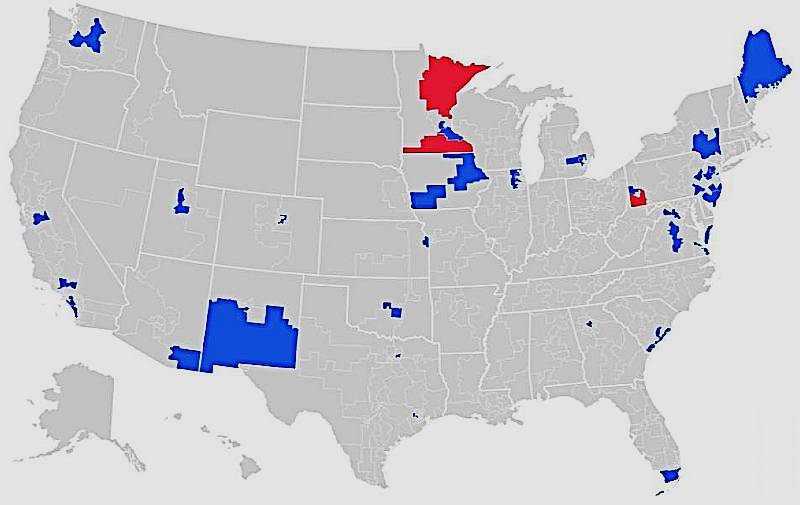
Who Won 2018 Midterms?
Radical “progressives” are attempting to take control of the Democratic party, and their pitch is this — We know how to win elections. They mean “big time,” as in a “political revolution.” One of their PACs is even called Brand New Congress.
If they’re right, then we can beat Trump easily by following their lead. If their wrong, we had better not. Let’s look before we leap.
The 2018 midterm elections provided the perfect test. The radical “progressives” went one way and the mainstream New Democrats went another. Both sides tried to flip house seats from red to blue. Here’s an excerpt from Chapter 16 of Ripped Apart, that tells what happened.
‘Our Revolution’ Meets the Jacksonians
Brand New Congress. A month after Reich’s 2016 op-ed [in which he envisioned a combined progressive-Tea Part revolution in 2020], 20 volunteers from Bernie Sanders’ campaign, led by top campaign staffer Zack Exley, formed “Brand New Congress.” As the Huffington Post explained at the time, they were “looking ahead to the 2018 midterm elections to replace Congress all at once” with lawmakers who agree with Sanders.
As Exley explained, “We want a supermajority in Congress … and I think we get it by running Dems in blue areas, Republicans in deep-red areas, and by running independents wherever we didn’t defeat incumbents.” The first step would be to recruit 400 Congressional candidates by July 2017.
Just after finally endorsing Hillary Clinton in July 2016, Sanders announced his plan to form his super PAC, “Our Revolution.” In early August, he began raising money for it and on August 24 he held a launch party.
In January 2017, Exley joined Saikat Chakrabarti, another top staffer from Sanders’ campaign, to form “Justice Democrats.” They recruited Alexandria Ocasio-Cortez, and two years later she was in Congress with Chakrabarti as her chief of staff.
Sanders’ PACs Tackle the 2018 Midterms
In November 2016, the Democrats lost the presidency and both houses of Congress, and in 2018, the House was their only real chance to retake some power. There were 82 “battleground” House races (as identified by Ballotpedia) that could flip a seat from red to blue or blue to red, and fortunately 73 of these started out Republican.
As we now know, a blue wave flipped 43 seats from red to blue while we lost only three blue seats. Democratic turnout was massive.
Sanders’ three PACs were, of course, busy “helping out.” They fielded many candidates and eventually, between the three of them, made 117 endorsements. Only 38 of these were for battleground seats. Surprisingly, the three PACs agreed on only two of these candidates. (Radical factionalism is legendary.)
So how many of their endorsed candidates were part of the 43 who flipped blue seats to red and gave us back the House? The shocking answer is none, as in zero. So much for taking a supermajority of Congress all at once. Bernie’s minions could not take back even a single seat from the Republicans.
And did they back any of the six Democrats who held onto their battleground seats? No. But they did back 10 Democrats who won. Who were they? The main thing to know is that every winning candidate they could find to endorse, whether their own candidate or an incumbent, was in a district where Clinton beat Trump by at least 30% (as in 65% to 35%). Apparently, with their politics, it’s unlikely a candidate can win if the district isn’t deep blue.
The most they could hope for, had they stopped their infighting, would have been to flip 40% of the Democratic seats from very progressive to Berniecrat progressive. That would just polarize the party and make it harder to get anything done.
Taking a look at the 10 winners they backed, we find that five were incumbents from deep-blue states that didn’t need their help. Another was Jesus Garcia, who scored 44% against Rahm Emanuel when he ran for Chicago Mayor in 2015. He didn’t need their help either.
The Big Win—Alexandria Ocasio-Cortez
The Bernie PACs’ final four victories are known as “the Squad,” so-called because they began posting “Squad pics” after the November election. They are Congresswomen Alexandria Ocasio-Cortez, Rashida Tlaib, Ilhan Omar, and Ayanna Pressley.
Ayanna Pressley primaried (to use a Tea-Party term that’s been picked up by some Berniecrats) Mike Capuano, a 10-term incumbent, and a member of the Congressional Progressive Caucus who supports Medicare-for-all. Pressley won 59 to 41%. She didn’t need the Bernie PACs. Nothing wrong with this, but nothing much accomplished.
Alexandria Ocasio-Cortez (AOC) primaried Joseph Crowley, a 10-term incumbent backed by the very-progressive Working Families Party. She won her primary by 4,018 votes with 7.2% of registered Democrats voting for her while Crowley got only 5.5%.
Her largest margins of support came from neighborhoods in western Queens with lower Latino populations and higher White populations. She did poorly in the Black neighborhoods.
Chakrabarti, president of Justice Democrats, recruited AOC early and put together a coalition made up largely of people who had organized for Bernie Sanders’ presidential campaign. They were joined by “Brand New Congress” and “Democratic Socialists of America,” but not by Sanders or his own super PAC, “Our Revolution.” Of course, it helped that Ocasio-Cortez performed her part brilliantly.
Ilhan Omar won her primary with 48.2% of the vote—not quite a landslide—and Rashida Tlaib won hers with only 31.2%.
Who Won the 2018 Midterms?
The entire “Squad” comes from dark-blue districts where Clinton decisively beat Trump by from 55% to 71%. (Yes, a 71% margin means 85% for Clinton and 14% for Trump!) Squad members and their supporters are on the left edge of those districts. They are in no way indicative of where the party or the country is or is headed.
The three Berniecrat PACs with their 117 endorsements didn’t manage to back a single candidate who came within a mile of making a difference. In contrast, the moderate “New Dem” PAC endorsed 77 candidates and 42 won, including 33 who flipped red seats to blue. The “New Dem” PAC is tied to the New Democratic Caucus in the House.
The most important takeaway from this analysis is that every non-Berniecrat Democrat is focused on fighting Trump, and they’re doing a damn good job of it. But Sanders and his PACs are focused on fighting only Democrats. In the crucial 2018 midterms, Berniecrats didn’t help at all.
They predicted they could take a super-majority of Congress, and all they could do is win four seats in deep-blue districts. That tells you exactly how much their super-optimistic predictions are worth.
Conclusion
To win in November 2020, we need to win the same way we did in 2018 by appealing to suburban women and some working-class whites that voted for Obama. Mainstream Democrats are good at this, while radical “progressives” have no idea what they are doing. They’re just good a beating Democrats in deep-blue districts. Here’s one of the main reasons the “progressives” miss their mark.
Based on Ch. 16 of Ripped Apart: How Democrats Can Fight Polarization to Win. This chapter can be read for free on Amazon by clicking “Look Inside,” and then on the chapter title in the table of contents. More about: Ripped Apart.

 Ripped Apart
Ripped Apart

